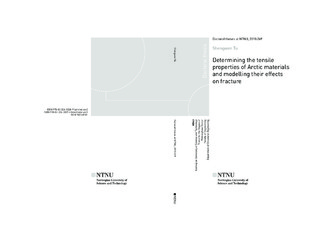| dc.contributor.advisor | Zhang, Zhiliang | |
| dc.contributor.advisor | Ren, Xiaobo | |
| dc.contributor.author | Tu, Shengwen | |
| dc.date.accessioned | 2019-02-14T09:26:52Z | |
| dc.date.available | 2019-02-14T09:26:52Z | |
| dc.date.issued | 2018 | |
| dc.identifier.isbn | 978-82-326-3329-6 | |
| dc.identifier.issn | 1503-8181 | |
| dc.identifier.uri | http://hdl.handle.net/11250/2585390 | |
| dc.description.abstract | The fracture behavior of metallic materials at low temperatures arise great attention among the petroleum industries, due to the potential considerable amount of petroleum and gas resources to be found there. Deep understanding of the mechanical behavior of steels at low temperatures will facilitate and provide solutions for safe and cost-effective application of materials for hydrocarbon exploration and production in arctic regions. In this thesis the low temperature effect on mechanical behavior of steels in several aspects has been studied and the results from five papers are presented.
The equivalent stress-strain curve is crucial for the structural integrity assessment with finite element method. Conventional methods for measuring equivalent stress-strain curves documented in testing codes are only suitable for homogeneous materials. Furthermore, the stress-strain curve derived with those methods need to be corrected after diffuse necking. In this thesis two methods have been developed to determine equivalent stress-strain curves of metallic materials. By introducing an axisymmetric notch on the smooth round bar specimen, the deformation is constrained in the notch region during the loading process. By performing the numerical study of true stress-strain curve from notched specimens, a corresponding procedure has been proposed to convert the true stress-strain curve from any notched specimens to material’s equivalent stress-strain. Meanwhile, we identified a ’magic’ notch geometry, with a single correction factor true stress-strain curve from this ’magic’ notched specimen can be corrected back to material’s equivalent stress-strain curve. These two methods can be applied to inhomogeneous materials by locating the notch in the target material zone, once the geometry requirements are fulfilled.
It is well understood that the fracture ductility of metallic materials depends on the stress state which constructs the ductility diagram (ductility vs. stress triaxiality). Most of the reported studies investigate the ductility diagram at room temperature. The low temperature effect on the evolution of ductility diagram is still missing. In this thesis we performed a series of tensile tests (45 tests in total) with axisymmetric notched and smooth round bar specimens with testing temperatures down to -60 ℃. The specimens were machined from a 420 MPa structural steel. A newly developed edge tracing method was used to monitor the specimen deformation and to evaluate the fracture ductility. It has been found that for this 420 MPa structural steel, the strength and strain hardening characterized by the strain at the maximum load increase with the decrease of testing temperature down to -60℃. While, the low temperature effect on the ductility diagram is insignificant.
For metallic materials presenting Lüders plateau in tensile test, the plateau length increases with the decrease of testing temperature. In the state of the art design codes, knowledge about the effect of Lüders plateau on the fracture behavior of metallic material is very limited. In this thesis, the effect of Lüders plateau on ductile crack growth has been investigated with Gurson damage model and single edge notched tensile (SENT) specimens. It has been found that the existence of Lüders plateau does not influence the initiation toughness but alters material’s ductile fracture resistance. The Lüders plateau effect on ductile crack resistance curve depends on the crack depth. It has been found that the Lüders plateau effect is controlled by the stress triaxiality ahead of the crack tip. For materials with smaller initial void volume fraction, the Lüders plateau effect was also observed and was more pronounced. In addition, for materials exhibiting Lüders plateau, both the effects of crack depth and strain hardening on crack resistance curve were reduced. The longer the Lüders plateau, the larger reduction. | nb_NO |
| dc.language.iso | eng | nb_NO |
| dc.publisher | NTNU | nb_NO |
| dc.relation.ispartofseries | Doctoral theses at NTNU;2018:269 | |
| dc.relation.haspart | Paper 1:
Tu, Shengwen; Ren, Xiaobo; Nyhus, Bård; Akselsen, Odd Magne; He, Jianying; Zhang, Zhiliang.
A special notched tensile specimen to determine the flow stress-strain curve of hardening materials without applying the Bridgman correction. Engineering Fracture Mechanics 2017 ;Volum 179. s. 225-239
https://doi.org/10.1016/j.engfracmech.2017.04.039 | |
| dc.relation.haspart | Paper 2:
Tu, Shengwen; Ren, Xiaobo; He, Jianying; Zhang, Zhiliang.
A method for determining material's equivalent stress-strain curve with any axisymmetric notched tensile specimens without Bridgman correction. International Journal of Mechanical Sciences 2018 ;Volum 135. s. 656-667
https://doi.org/10.1016/j.ijmecsci.2017.12.012 | |
| dc.relation.haspart | Paper 3:
Shengwen Tu; Xiaobo Ren; Jianying He; Zhiliang Zhang
Experimental measurement of temperature-dependent equivalent stress-strain curve
of a 420 MPa structural steel with axisymmetric notched tensile specimens | |
| dc.relation.haspart | Paper 4:
Tu, Shengwen; Ren, Xiaobo; Kristensen, Tore Andre; He, Jianying; Zhang, Zhiliang.
Study of low-temperature effect on the fracture locus of a 420-MPa structural steel with the edge tracing method. Fatigue & Fracture of Engineering Materials & Structures 2018 ;Volum 41.(8) s. 1649-1661
- The final published version is available at
https://doi.org/10.1111/ffe.12803 | |
| dc.relation.haspart | Paper 5:
Tu, Shengwen; Ren, Xiaobo; He, Jianying; Zhang, Zhiliang.
Numerical study on the effect of the Lüders plateau on the ductile crack growth resistance of SENT specimens. International Journal of Fracture 2018 ;Volum 214.(2) s. 185-200
Is not included due to copyright available at
https://doi.org/10.1007/s10704-018-0327-2 | |
| dc.title | Determining the tensile properties of Arctic materials and modelling their effects on fracture | nb_NO |
| dc.type | Doctoral thesis | nb_NO |
| dc.subject.nsi | VDP::Technology: 500::Building technology: 530::Construction technology: 533 | nb_NO |

